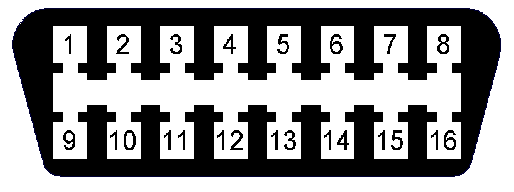Does My Car Have OBD-II?
All cars and light trucks built and sold in the United States after January 1, 1996 were required to be OBD II equipped. In general, this means all 1996 model year cars and light trucks are compliant, even if built in late 1995.
Two factors will show if your vehicle is definitely OBD II equipped:
1) There will be an OBD II connector as shown below, and
2) There will be a note on a sticker or nameplate under the hood: "OBD II compliant".
The Connector

Pin 2 - J1850 Bus+
Pin 4 - Chassis Ground
Pin 5 - Signal Ground
Pin 6 - CAN High (J-2284)
Pin 7 - ISO 9141-2 K Line
Pin 10 - J1850 Bus
Pin 14 - CAN Low (J-2284)
Pin 15 - ISO 9141-2 L Line
Pin 16 - Battery Power
Where is the connector located?
The connector must be located within three feet of the driver and must not require any tools to be revealed. Look under the dash and behind ashtrays.
The Three Flavors of OBD II
While the parameters, or readings, required by OBD II regulations are uniform, the auto manufacturers had some latitude in the communications protocol they used to transmit those readings to scanners. Naturally, each felt they had the one true way, so we have three different OBD II communications protocols in use.
The big scanner consoles costing thousands of dollars include the decoding software and firmware for all three protocols in their units, making them universal. Less expensive units, for home or small shop use, are usually customized for a specific communications protocol. Be sure the scanner you are using suits the protocol of your car.
What Communications Protocol does my vehicle use?
As a rule of thumb, GM cars and light trucks use SAE J1850 VPW (Variable Pulse Width Modulation). Chrysler products and all European and most Asian imports use ISO 9141 circuitry. Fords use SAE J1850 PWM (Pulse Width Modulation) communication patterns.
There are some variations among captive imports such as the Cadillac Catera, a German Opel derivative, which uses the European ISO 9141 protocol. If you have first hand knowledge of other such variations, please send them in and, together, we can build a more complete listing.
On 1996 and later vehicles, you can tell which protocol is used by examining the OBD II connector:
J1850 VPW--The connector should have metallic contacts in pins 2, 4, 5, and 16, but not 10.
ISO 9141-2--The connector should have metallic contacts in pins 4, 5, 7, 15, and 16.
J1850 PWM--The connector should have metallic contacts in pins 2, 4, 5, 10, and 16.
If your vehicle has this style connector, but doesn't have these pins populated, you probably have a pre-OBDII vehicle. To add some confusion, even having the connector with the contacts shown above is not a guarantee of OBD II compliance. This style connector has been seen on some pre-1996 vehicles which were not OBD II compliant.
Information on Pre-96 Cars
A reader with the California Air Resouces Board provided this list of pre-96 OBD II engine designations. Note that CARB recognizes engine series, rather than vehicle models, so the engine designations are the true key, with the vehicle models provided as a courtesy.
California Air Resources Board List of
Certified OBD II Complying Engine Families and Models
|